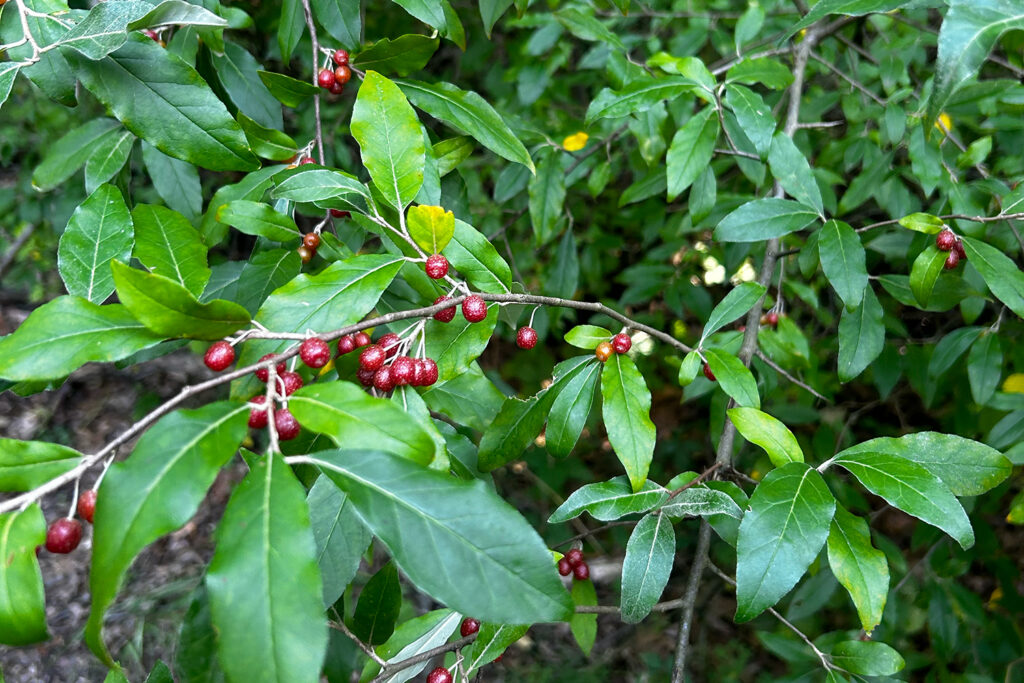Send in the Goats

I know the Autumn Olive well, and I hate it. I’ve spent many mornings in the dark, fighting an endless sea of this invasive and prickly plant. Torn up, sweaty, and angry.
At first glance, it probably seems like any ordinary shrub (though it can grow up to 20 feet tall), with silver-green leaves and bunches of red berries that are hard to miss. Most Michiganders probably wouldn’t even notice it, but it’s everywhere. And while it doesn’t have true thorns, it has sharp, stiff branches that have shredded more than a few of my shirts.
But the real damage isn’t to my clothes. This invasive shrub is quietly fueling one of Michigan’s growing public health threats: an explosion in ticks and the diseases they carry.
I’ve written about Michigan’s tick problem in the past. It’s not a small issue. Usually, people blame global warming and land-use changes, but we can’t overlook the role invasive plants play. Autumn Olive is not just an invasive species (reason enough to destroy it from the face of our fine state), it’s the perfect partner in crime for ticks.
The Soil Conservation Service introduced the shrub to North America in the 1830s. It’s native to East Asia, but the experts expected it to do well in poor soil conditions and provide quick-growing habitat for wildlife in North America. The problem is that it has few natural predators here. Deer seem to love living in Autumn Olive clusters, but they sure don’t seem to eat any.
The experts thought it would be the perfect solution to erosion. Boy, were they wrong.
This hardy plant grows quickly, creating dense thickets that outcompete our native plants. Each can produce up to 200,000 seeds each year, which birds end up spreading all over the place. It seems to create nearly impenetrable barriers of shiny green leaves and branches that grab a hold of you. And it grows in ditches, overgrown fields, and, for some reason, always between me and my deer stands.
The Autumn Olive invasion is a boon for ticks. The plant grows thick and fast, creating the warm, moist, shaded microclimates ticks love. Evil begets more evil. The more Autumn Olive spreads, the more territory ticks have to call home.
This isn’t just anecdotal either; research backs it up. More Autumn Olive means more ticks. The plant is quietly reshaping Michigan’s landscape in favor of these bloodsucking parasites, and no one is talking about it.
It outcompetes native plants and changes the very chemistry of the soil around it. Nitrogen levels get so high that native plants struggle to survive. The entire ecosystem changes. In our world and in the woods, everything is connected.
But recognizing the problem isn’t a solution. We’ve got to come up with a plan to eradicate this shrub en masse. Sure, you can pull it up when you find it on your property, and you should (don’t cut it back or burn it, however, because it germinates easily). That’s a great start, but this isn’t just a backyard battle. We need the state to step up more too.
It’s time to send in the goats. Believe it or not, goats and sheep are more than happy to eat up Autumn Olive shrubs. Goats especially can do a ton of damage. They’ll debark branches, don’t mind the sharp twigs, and they work quickly. This is known as prescribed grazing. This animal-based attempt at defoliations has been shown to be very effective when done at the state-level.
It’s a low-cost, low-impact way to get our land back. Others states have already used it with great success. Oregon deployed goats to clear out blackberry bushes, and New York has deployed the goats to fight invasive plants in state parks. It’s all-natural, effective, and scalable.
If we don’t take this seriously, Michigan will only have more invasive plants, more ticks, and more diseases. The longer we wait, the worse it’ll get. Autumn Olive is more than an eyesore, it’s a major player in Michigan’s tick problem. Send in the cloven-footed troops and make them part of a broader strategy to reclaim our land.
Tim Dawson is an experienced outdoorsman with a passion for the Mitten State. Follow him on X @TheFairChase1.